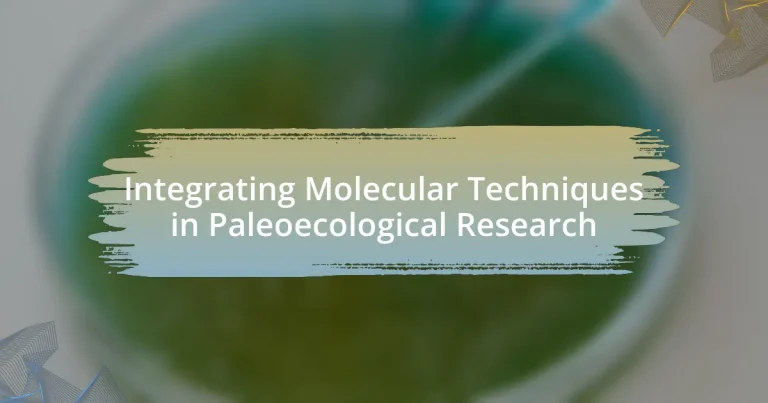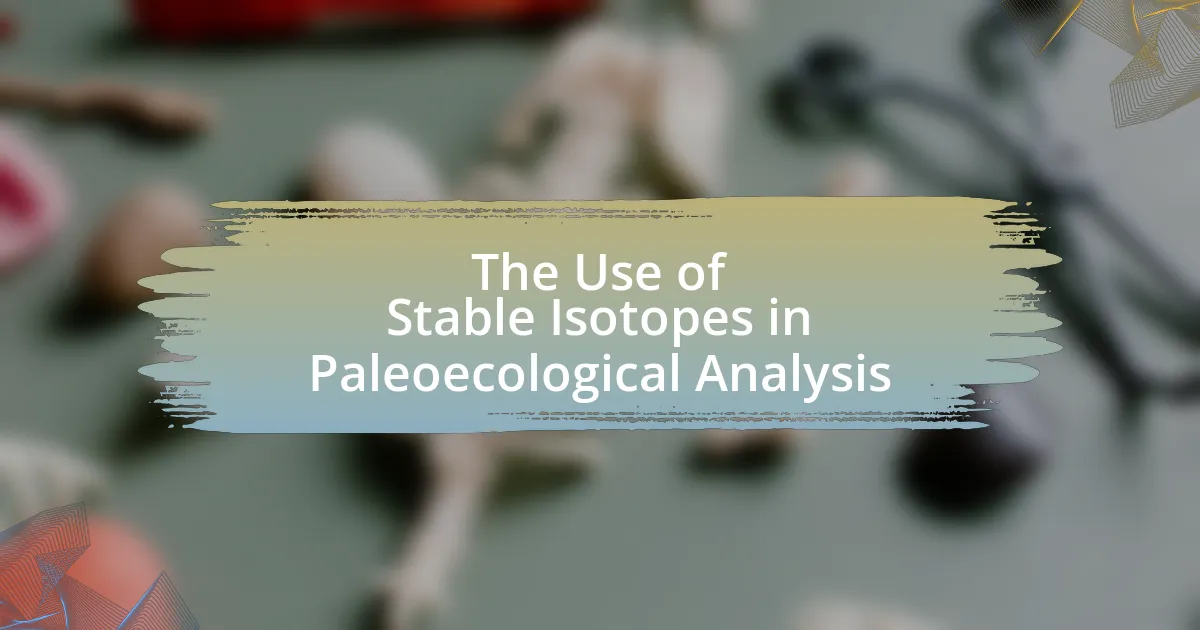Molecular techniques in paleoecological research involve the application of molecular biology tools to analyze ancient biological materials, such as DNA, proteins, and lipids, to reconstruct past ecosystems and assess biodiversity changes. Key methods include ancient DNA analysis, environmental DNA sampling, and stable isotope analysis, which enhance understanding of species composition, population dynamics, and environmental conditions over time. The integration of these techniques offers a more precise understanding of historical ecosystems compared to traditional approaches, while also addressing challenges such as DNA degradation and contamination. Future advancements in sequencing technologies and bioinformatics are expected to further improve the accuracy and scope of paleoecological studies.

What are Molecular Techniques in Paleoecological Research?
Molecular techniques in paleoecological research are methods that utilize molecular biology tools to analyze ancient biological materials, such as DNA, proteins, and lipids, to reconstruct past ecosystems and understand biodiversity changes over time. These techniques, including ancient DNA analysis, environmental DNA (eDNA) sampling, and stable isotope analysis, allow researchers to identify species composition, track population dynamics, and assess environmental conditions from sediment cores and other geological samples. For instance, studies have shown that ancient DNA can provide insights into the extinction events and climate changes that affected species distributions, as evidenced by research published in “Nature” by Willerslev et al. (2014), which demonstrated the recovery of DNA from permafrost sediments to reveal past biodiversity.
How do molecular techniques enhance our understanding of past ecosystems?
Molecular techniques enhance our understanding of past ecosystems by allowing scientists to analyze ancient DNA, proteins, and other biomolecules, which provide insights into species composition, population dynamics, and environmental conditions. For instance, the extraction and sequencing of ancient DNA from sediment cores can reveal the presence and abundance of various organisms over time, enabling researchers to reconstruct past biodiversity and ecological interactions. Studies, such as those published in “Nature” by Willerslev et al. (2014), demonstrate how these techniques can identify extinct species and track changes in ecosystems in response to climate shifts, thereby offering a more detailed and accurate picture of historical ecological landscapes.
What specific molecular methods are commonly used in paleoecology?
Specific molecular methods commonly used in paleoecology include ancient DNA (aDNA) analysis, stable isotope analysis, and biomarker analysis. Ancient DNA analysis allows researchers to extract and sequence genetic material from archaeological and sediment samples, providing insights into past biodiversity and species interactions. Stable isotope analysis helps in reconstructing past environmental conditions by examining isotopic ratios in organic materials, which reflect dietary and climatic information. Biomarker analysis involves identifying specific organic compounds that indicate the presence of particular organisms or environmental conditions, aiding in the interpretation of paleoecological data. These methods collectively enhance the understanding of historical ecosystems and their responses to climate change.
How do these methods compare to traditional paleoecological approaches?
Molecular techniques provide a more precise and detailed understanding of past ecosystems compared to traditional paleoecological approaches. While traditional methods often rely on physical and chemical analyses of sediment cores and fossil records, molecular techniques, such as ancient DNA analysis and environmental DNA (eDNA) sampling, allow for the identification of species and their interactions at a genetic level. For instance, studies have shown that eDNA can detect species presence in sediment samples with greater sensitivity than morphological identification, revealing a more comprehensive picture of biodiversity and ecological dynamics over time. This enhanced resolution enables researchers to reconstruct past environments and biotic interactions more accurately, thus offering insights that traditional methods may overlook.
Why is the integration of molecular techniques important in paleoecology?
The integration of molecular techniques is important in paleoecology because it enhances the understanding of past ecosystems and biodiversity through genetic analysis. Molecular techniques, such as ancient DNA (aDNA) analysis, allow researchers to identify species that were present in specific time periods, providing insights into species interactions and environmental changes. For instance, studies have shown that aDNA can reveal the presence of extinct species, such as the woolly mammoth, and their relationships with contemporary species, thereby informing on evolutionary processes and extinction events. This genetic information complements traditional paleoecological methods, leading to a more comprehensive understanding of historical ecological dynamics.
What insights can molecular techniques provide that other methods cannot?
Molecular techniques provide insights into genetic diversity and species identification that other methods cannot achieve. These techniques, such as DNA sequencing and ancient DNA analysis, allow researchers to uncover genetic material from extinct species and assess population structures over time. For instance, studies have shown that ancient DNA can reveal the presence of species that were previously undetectable through traditional fossil analysis, thus enhancing our understanding of past ecosystems and biodiversity. Additionally, molecular techniques can identify specific genetic markers that indicate environmental adaptations, which are often overlooked by morphological assessments alone. This capability to analyze genetic data provides a more nuanced understanding of evolutionary processes and ecological interactions in paleoecological research.
How do molecular techniques contribute to biodiversity assessments in ancient environments?
Molecular techniques significantly enhance biodiversity assessments in ancient environments by enabling the extraction and analysis of genetic material from preserved biological samples. These techniques, such as ancient DNA (aDNA) analysis, allow researchers to identify species that existed in the past, even from fragmented or degraded specimens. For instance, studies have successfully utilized aDNA to reconstruct past ecosystems, revealing the presence of extinct species and providing insights into species interactions and environmental changes over time. This genetic information is crucial for understanding historical biodiversity patterns and the evolutionary processes that shaped them, as demonstrated by research published in “Nature” by Hofreiter et al. (2015), which highlighted the role of aDNA in reconstructing Pleistocene megafauna communities.

What are the Challenges of Integrating Molecular Techniques in Paleoecological Research?
The challenges of integrating molecular techniques in paleoecological research include issues related to DNA degradation, contamination, and the interpretation of ancient genetic data. DNA from ancient samples often undergoes fragmentation and chemical modifications over time, making it difficult to obtain high-quality sequences. Contamination from modern DNA can further complicate results, leading to inaccurate conclusions about past ecosystems. Additionally, interpreting ancient genetic data requires careful consideration of evolutionary processes and environmental contexts, which can be complex and multifaceted. These challenges necessitate the development of robust methodologies and interdisciplinary approaches to enhance the reliability of molecular insights in paleoecology.
What technical limitations exist when applying molecular techniques to paleoecological samples?
Technical limitations when applying molecular techniques to paleoecological samples include DNA degradation, contamination risks, and low biomass availability. DNA from ancient samples often undergoes fragmentation and chemical modifications over time, making it challenging to obtain high-quality sequences. Additionally, the presence of modern DNA can lead to contamination, complicating the interpretation of results. Furthermore, paleoecological samples may contain insufficient quantities of genetic material, hindering the ability to perform robust analyses. These factors collectively restrict the accuracy and reliability of molecular data in reconstructing past ecological conditions.
How do preservation conditions affect the quality of molecular data?
Preservation conditions significantly impact the quality of molecular data by influencing the integrity and stability of genetic material. Factors such as temperature, humidity, and the presence of contaminants can lead to DNA degradation, resulting in lower quality sequences and incomplete data. For instance, studies have shown that samples stored at higher temperatures exhibit increased rates of DNA fragmentation, which compromises the reliability of molecular analyses. Additionally, the use of appropriate preservatives, such as ethanol or silica gel, can enhance the preservation of nucleic acids, thereby improving the overall quality of molecular data obtained from paleoecological samples.
What are the challenges in interpreting molecular data in a paleoecological context?
Interpreting molecular data in a paleoecological context presents several challenges, primarily due to the degradation of DNA over time and the complexities of ancient environmental reconstructions. The preservation of molecular material is often poor in fossilized remains, leading to potential contamination and misinterpretation of results. Additionally, the evolutionary changes in species and their genetic markers complicate the correlation between molecular data and paleoecological conditions. Studies have shown that ancient DNA can be fragmented and chemically altered, which affects the reliability of phylogenetic analyses. Furthermore, the lack of comprehensive reference databases for extinct species limits the ability to accurately interpret molecular sequences in relation to past ecosystems.
How can researchers overcome these challenges?
Researchers can overcome challenges in integrating molecular techniques in paleoecological research by adopting interdisciplinary approaches, enhancing collaboration among fields such as genetics, ecology, and geology. This collaboration facilitates the sharing of methodologies and expertise, which is crucial for addressing complex issues like sample degradation and contamination. For instance, utilizing advanced DNA extraction and sequencing technologies can improve the quality of ancient DNA analysis, thereby yielding more reliable data. Additionally, training programs that focus on molecular techniques for paleoecologists can bridge knowledge gaps, ensuring researchers are equipped with the necessary skills to implement these methods effectively.
What best practices should be followed when collecting and analyzing molecular data?
Best practices for collecting and analyzing molecular data include ensuring sample integrity, using appropriate controls, and employing standardized protocols. Maintaining sample integrity involves proper storage conditions and minimizing contamination risks, which is critical for accurate results. Utilizing appropriate controls, such as negative and positive controls, helps validate the experimental process and ensures reliability. Employing standardized protocols, like those recommended by the International Society for Molecular Ecology, enhances reproducibility and comparability across studies. These practices are essential for producing high-quality molecular data that can be reliably interpreted in paleoecological research.
How can interdisciplinary collaboration enhance the integration of molecular techniques?
Interdisciplinary collaboration can enhance the integration of molecular techniques by combining expertise from various scientific fields, leading to more comprehensive research outcomes. For instance, collaboration between molecular biologists, ecologists, and geologists can facilitate the development of innovative methodologies that leverage molecular data to reconstruct past ecosystems more accurately. This approach has been validated by studies such as those conducted by Willerslev et al. (2014), which demonstrated that integrating genetic data with ecological and geological insights significantly improved the understanding of ancient biodiversity and environmental changes. Such collaborations enable the sharing of diverse perspectives and techniques, ultimately enriching the research process and outcomes in paleoecological studies.

What Future Directions Exist for Molecular Techniques in Paleoecological Research?
Future directions for molecular techniques in paleoecological research include advancements in ancient DNA analysis, metagenomics, and isotopic analysis. These techniques enable researchers to reconstruct past ecosystems with greater accuracy and detail. For instance, ancient DNA analysis allows for the identification of extinct species and their interactions within ecosystems, while metagenomics provides insights into microbial communities and their roles in historical biogeochemical cycles. Additionally, isotopic analysis can reveal information about past climate conditions and dietary habits of ancient organisms. Collectively, these molecular techniques enhance our understanding of biodiversity changes over time and inform conservation strategies for current ecosystems.
What emerging technologies are likely to impact molecular paleoecology?
Emerging technologies likely to impact molecular paleoecology include advanced sequencing techniques, bioinformatics tools, and environmental DNA (eDNA) analysis. Advanced sequencing techniques, such as next-generation sequencing (NGS), enable the rapid and cost-effective analysis of ancient DNA, allowing researchers to reconstruct past ecosystems with greater accuracy. Bioinformatics tools facilitate the processing and interpretation of large datasets generated by these sequencing methods, enhancing the ability to identify species and understand ecological interactions. Environmental DNA analysis allows for the detection of genetic material from organisms in sediment or water samples, providing insights into historical biodiversity and ecosystem changes without the need for physical specimens. These technologies collectively enhance the resolution and scope of molecular paleoecological studies, enabling a deeper understanding of past environments and their responses to climate change.
How might advancements in sequencing technologies change paleoecological studies?
Advancements in sequencing technologies will significantly enhance paleoecological studies by enabling more precise and comprehensive analysis of ancient DNA and environmental samples. These technologies, such as high-throughput sequencing, allow researchers to recover genetic material from sediment cores and fossils, providing insights into past biodiversity, species interactions, and ecosystem responses to climate change. For instance, studies utilizing next-generation sequencing have successfully extracted and analyzed ancient DNA from permafrost, revealing the presence of extinct species and their ecological roles. This capability to analyze complex genetic data from various sources will lead to a deeper understanding of historical ecosystems and their dynamics, ultimately transforming the field of paleoecology.
What role will bioinformatics play in the future of molecular paleoecology?
Bioinformatics will play a crucial role in the future of molecular paleoecology by enabling the analysis and interpretation of complex genetic data from ancient organisms. As molecular techniques advance, bioinformatics will facilitate the reconstruction of past ecosystems through the analysis of ancient DNA, allowing researchers to identify species, understand their interactions, and assess environmental changes over time. For instance, studies have shown that bioinformatics tools can process large datasets from metagenomic analyses, which can reveal biodiversity patterns and ecological dynamics in historical contexts. This integration of bioinformatics will enhance the accuracy and efficiency of paleoecological research, ultimately leading to more comprehensive insights into the evolution of ecosystems.
What practical tips can researchers follow to effectively integrate molecular techniques?
Researchers can effectively integrate molecular techniques by adopting a multidisciplinary approach that combines molecular biology with traditional paleoecological methods. This integration can be achieved through the careful selection of molecular markers, such as DNA barcoding, which allows for precise species identification and biodiversity assessments. Additionally, researchers should ensure proper sample collection and preservation techniques to maintain the integrity of genetic material, as demonstrated by studies showing that degraded samples can yield valuable genetic information when handled correctly. Training in bioinformatics is also essential, as it enables researchers to analyze complex genomic data and interpret results accurately, thereby enhancing the overall quality of paleoecological research.
How can researchers ensure the reliability of molecular data in paleoecological studies?
Researchers can ensure the reliability of molecular data in paleoecological studies by implementing rigorous sampling protocols, utilizing advanced sequencing technologies, and applying robust bioinformatics analyses. Rigorous sampling protocols minimize contamination and ensure representative samples, which is crucial for accurate data interpretation. Advanced sequencing technologies, such as next-generation sequencing, provide high-resolution data that enhances the detection of molecular signatures from ancient organisms. Additionally, robust bioinformatics analyses, including quality control measures and statistical validation, help to confirm the authenticity and accuracy of the molecular data. Studies have shown that these combined approaches significantly improve the reliability of molecular data, as evidenced by successful applications in reconstructing past ecosystems and understanding biodiversity changes over time.
What resources are available for researchers new to molecular techniques in paleoecology?
Researchers new to molecular techniques in paleoecology can access a variety of resources, including online courses, workshops, and specialized literature. For instance, the American Society of Plant Taxonomists offers workshops focused on molecular techniques applicable to paleoecology. Additionally, the book “Molecular Paleobiology” by David J. Bottjer provides foundational knowledge and methodologies relevant to this field. Online platforms like Coursera and edX also offer courses on molecular biology that can be beneficial for understanding the techniques used in paleoecological research. These resources collectively support researchers in acquiring the necessary skills and knowledge to effectively utilize molecular techniques in their studies.





